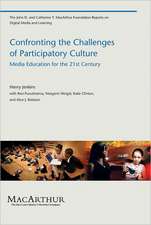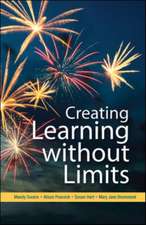The Self-Monitoring Primary School
Autor Cyril Poster, Pearl Whiteen Limba Engleză Paperback – 6 mar 1997
Specific areas focused on include:
* developing a quality control framework
* the importance of a whole-school approach to policy making
* developing a school-wide system to monitor plans
* observing and promoting differentiation in the classroom
* the role LEAs must play in monitoring school effectiveness
| Toate formatele și edițiile | Preț | Express |
|---|---|---|
| Paperback (1) | 407.31 lei 43-57 zile | |
| Taylor & Francis – 6 mar 1997 | 407.31 lei 43-57 zile | |
| Hardback (1) | 929.57 lei 43-57 zile | |
| Taylor & Francis – 15 aug 2017 | 929.57 lei 43-57 zile |
Preț: 407.31 lei
Nou
Puncte Express: 611
Preț estimativ în valută:
77.95€ • 80.88$ • 65.15£
77.95€ • 80.88$ • 65.15£
Carte tipărită la comandă
Livrare economică 17-31 martie
Preluare comenzi: 021 569.72.76
Specificații
ISBN-13: 9780415148177
ISBN-10: 0415148170
Pagini: 150
Dimensiuni: 156 x 234 x 8 mm
Greutate: 0.25 kg
Ediția:1
Editura: Taylor & Francis
Colecția Routledge
Locul publicării:Oxford, United Kingdom
ISBN-10: 0415148170
Pagini: 150
Dimensiuni: 156 x 234 x 8 mm
Greutate: 0.25 kg
Ediția:1
Editura: Taylor & Francis
Colecția Routledge
Locul publicării:Oxford, United Kingdom
Public țintă
ProfessionalRecenzii
'For any school wanting to introduce or update their monitoring strategies this book would be a useful guide and handbook' - Managing Schools Today
Cuprins
Introduction Chapter 1: The Purpose of Monitoring Chapter 2. The Management of Monitoring Chapter 3. Policies, Planning and Procedures Chapter 4. How Do We Monitor? Chapter 5. Monitoring in the Classroom Chapter 6. Planning and Monitoring Provision for Diversity Chapter 7. The Role of the LEA
Descriere
Many schools are concerned that external OFSTED inspections are overjudgemental. This book describes the self-monitoring process. It shows how schools can improve whilst controlling their rate of development and prioritizing its stages.










